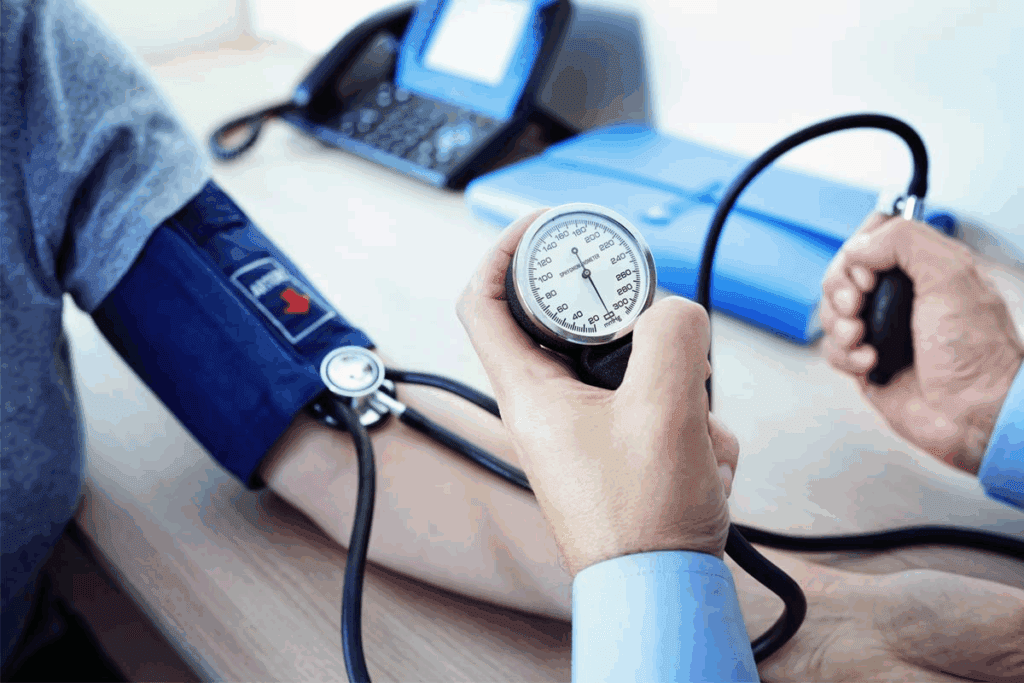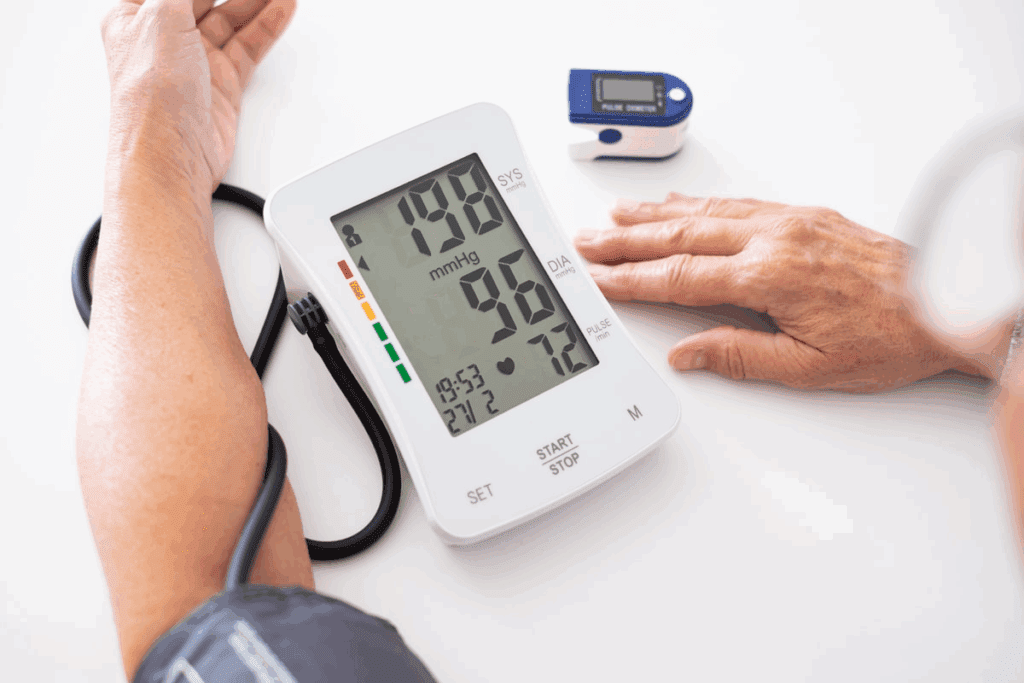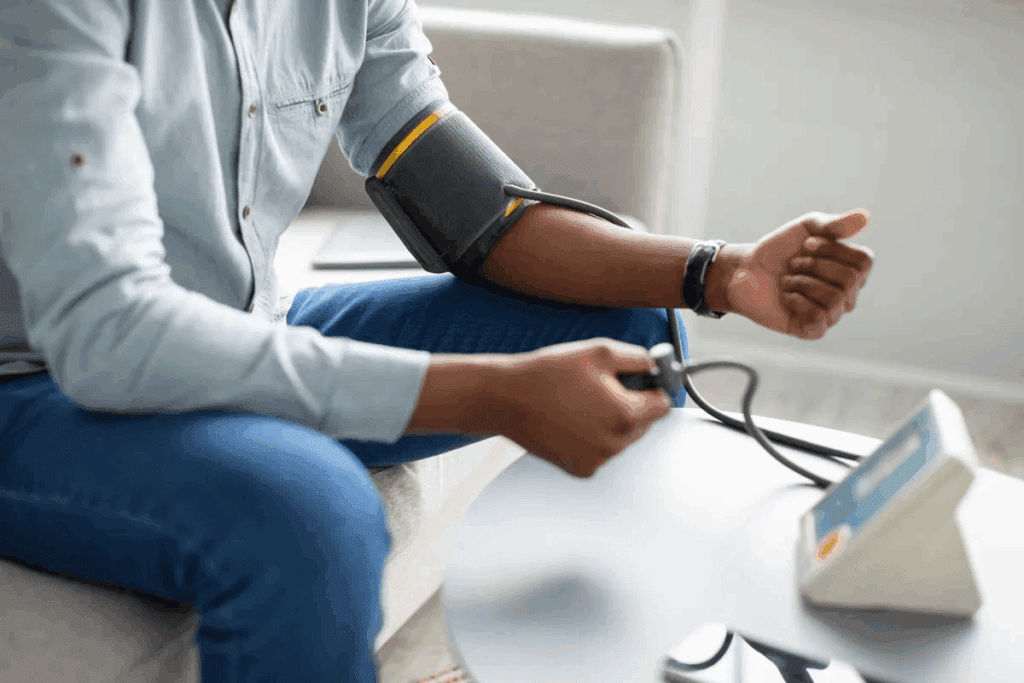Last Updated on October 31, 2025 by Batuhan Temel

Knowing your blood pressure readings is key to staying healthy. At Liv Hospital, we stress the importance of understanding your numbers. Understand 108 68 blood pressure and what your reading reveals about your health.
The American Heart Association (AHA) says a healthy blood pressure is under 120/80 mm Hg. We’ll look into what these specific numbers mean for your health and well-being.

Blood pressure readings give us insights into our heart health. Doctors use them to check our heart and spot problems early.
A sphygmomanometer is used to measure blood pressure. It wraps a cuff around your upper arm. The cuff is inflated to stop blood flow, then deflated slowly.
When blood starts flowing again, the systolic pressure is measured. The diastolic pressure is when blood flows freely. You can use a manual or digital sphygmomanometer for this.
The blood pressure reading has two numbers. The systolic pressure is the top number, showing the highest pressure in your arteries during a heartbeat. The diastolic pressure is the bottom number, showing the lowest pressure between heartbeats.
For example, in a reading of 108/68, the systolic is 108 mmHg, and the diastolic is 68 mmHg.
Blood pressure is divided into categories based on systolic and diastolic values. Knowing these categories helps you understand your health and what steps to take to improve it.
| Blood Pressure Category | Systolic Pressure (mmHg) | Diastolic Pressure (mmHg) |
| Normal | Less than 120 | Less than 80 |
| Elevated | 120-129 | Less than 80 |
| Stage 1 Hypertension | 130-139 | 80-89 |
| Stage 2 Hypertension | 140 or higher | 90 or higher |
For example, a reading of 108/68 is in the ‘Normal’ category. This means your blood pressure is healthy, which lowers your risk of heart disease.

Seeing a blood pressure reading of 108/68 might make you wonder if it’s good or if there are hidden issues. This reading is usually seen as normal, according to the NHS and other health guidelines.
A blood pressure reading has two numbers: systolic (top) and diastolic (bottom). A 108/68 reading means your systolic is 108 and diastolic is 68. Both are in the normal range for adults.
To see if 108/68 is normal, let’s look at blood pressure categories:
| Blood Pressure Category | Systolic (mmHg) | Diastolic (mmHg) |
| Normal | Less than 120 | Less than 80 |
| Elevated | 120-129 | Less than 80 |
| Stage 1 Hypertension | 130-139 | 80-89 |
| Stage 2 Hypertension | 140 or higher | 90 or higher |
As the table shows, 108/68 is in the “Normal” category. Medical Expert, a cardiologist, says, “A normal reading like 108/68 is good for heart health. But, it’s important to think about lifestyle, family history, and overall health too.”
Several things can lead to a 108/68 blood pressure reading. These include:
Readings like 109/60 or 111/68 are also normal. Small changes can happen due to many factors, like the time of day, how hydrated you are, and how active you’ve been.
In summary, a 108/68 blood pressure reading is usually a sign of good health. But, it’s key to keep a healthy lifestyle and check your blood pressure often to stay in the normal range.
These blood pressure readings – 105/57, 111/68, and 109/60 – are often in the normal range. But what do they really mean? Knowing these numbers is key to understanding heart health.
The readings 105/57 and 111/68 are close to normal. The top number, or systolic, is similar for both. But the bottom number, or diastolic, is different. A diastolic of 57 is low-normal, while 68 is normal.
To better understand these readings, let’s look at a comparison:
| Blood Pressure Reading | Systolic Value | Diastolic Value | Classification |
| 105/57 | 105 | 57 | Low-Normal |
| 111/68 | 111 | 68 | Normal |
| 109/60 | 109 | 60 | Normal |
A blood pressure reading of 109/60 is generally good. The systolic pressure of 109 is normal. The diastolic pressure of 60 is a bit low but also normal. The American Heart Association says a normal blood pressure is below 120/80 mmHg.
“Maintaining a blood pressure within the normal range is key for heart health.” – American Heart Association
Readings like 105/57, 111/68, and 109/60 show good heart health. But, it’s important to look at overall health, lifestyle, and any symptoms.
Key factors to consider:
By understanding these blood pressure readings and living a healthy lifestyle, people can lower their risk of heart disease. This promotes overall well-being.
Having blood pressure readings like 104/71 or 106/66 is good for your heart. It shows your heart and blood vessels are working well.
Low blood pressure can lower your risk of heart disease and stroke. It also means you’re less likely to have kidney disease.
Some benefits include:
People with blood pressure like 110/59 often have certain traits. These traits include:
| Characteristic | Description |
| Regular Physical Activity | Regular exercise helps keep blood pressure healthy. |
| Balanced Diet | Eating fruits, veggies, and whole grains helps keep blood pressure low. |
| Healthy Weight | Being at a healthy weight lowers the risk of high blood pressure. |
Even though low blood pressure is good, there are times to watch it closely. If you feel dizzy, faint, or tired, see a doctor.
Also, if you have health issues or take medicines that affect blood pressure, keep an eye on it.
It’s important to understand blood pressure readings, even when they’re borderline low. Numbers like 90/56 or 92/60 are in a gray area. They’re not quite normal, but not low either.
What’s normal and what’s low isn’t always clear. A reading below 90/60 mmHg is usually low. But numbers just above, like 90/56, 92/60, or 99/62, are borderline low.
These numbers are important because they might show a trend towards low blood pressure. Even healthy people can have these readings. Blood pressure changes throughout the day due to many factors.
Several things can lead to borderline low blood pressure. Here are some common causes:
Borderline low readings might not always be a worry. But, if you feel dizzy, faint, or have trouble breathing, see a doctor.
If you have heart disease or other health issues, watch your blood pressure closely. Talk to your doctor about any changes.
“Monitoring blood pressure regularly and understanding the factors that influence it can help individuals take proactive steps towards maintaining their cardiovascular health.”
— American Heart Association
In summary, borderline low blood pressure readings like 90/56, 92/60, and 99/62 need attention. Knowing the causes and when to see a doctor can help manage blood pressure and health.
When you see blood pressure readings like 84/66, 94/43, or 92/53, it’s important to know what they mean. These numbers are low and might show health problems that need attention.
Hypotension, or blood pressure under 90/60, can signal a health issue. We’ll look at what causes and symptoms of hypotension are. This will help us understand its impact.
Key aspects of hypotension include:
Low blood pressure can show itself in different ways. Some symptoms are mild, while others are severe. Common symptoms include:
| Symptom | Description |
| Dizziness or Lightheadedness | Feeling faint or dizzy, specially when standing up quickly. |
| Fainting (Syncope) | Temporary loss of consciousness due to inadequate blood flow to the brain. |
| Fatigue | Feeling unusually tired or weak, which can be a sign of inadequate blood circulation. |
It’s important to recognize these symptoms. They can help identify hypotension and guide you to seek medical care.
Several medical conditions can lead to very low blood pressure readings. These include:
Knowing these causes can help in diagnosing and managing hypotension effectively.
It’s important to understand unusual blood pressure readings to check heart health. Readings that don’t follow the usual pattern might show health problems. We’ll look at what 116/55, 113/53, and 106/72 mean, focusing on wide and narrow pulse pressure.
Wide pulse pressure means the systolic and diastolic readings are far apart. For example, 116/55 has a pulse pressure of 61. This can be due to aortic regurgitation, severe anemia, or hyperthyroidism. It shows the heart might be working too hard, which could lead to heart problems if not treated.
A medical expert says, “A wide pulse pressure can be a sign of an underlying cardiovascular issue that requires medical attention.”
“The pulse pressure is an important indicator of cardiovascular health, and a wide pulse pressure can be associated with increased risk of heart disease.”
Medical Expert, Cardiologist
Narrow pulse pressure means the systolic and diastolic readings are close. For instance, 106/72 has a pulse pressure of 34. Though it might seem less serious than wide pulse pressure, it can also signal health problems like heart failure or significant blood loss. It’s key to watch these readings and talk to a doctor.
| Blood Pressure Reading | Pulse Pressure | Potential Implications |
| 116/55 | 61 | Wide pulse pressure; possible cardiovascular issues |
| 113/53 | 60 | Wide pulse pressure; possible underlying health conditions |
| 106/72 | 34 | Narrow pulse pressure; possible heart-related issues |
Wide and narrow pulse pressures can tell us a lot about heart health. A wide pulse pressure might show the heart can’t pump blood well. A narrow pulse pressure could mean the heart isn’t pumping enough. Knowing these patterns helps doctors find and treat heart problems better.
People with unusual blood pressure readings should work closely with their doctors. This way, they can keep their heart healthy and avoid serious heart problems.
Monitoring your blood pressure at home is key to managing your heart health. With the right tools and methods, you can learn a lot about your blood pressure. This knowledge helps you make smart health choices.
To get accurate readings, follow some important steps. Choose a reliable blood pressure monitor that meets your needs. Always use it as the manufacturer suggests.
Sit comfortably with your back straight, feet on the floor, and arm at heart level. This ensures accurate measurements.
Consistency is key when tracking blood pressure at home. Take readings at the same times each day. This helps capture your blood pressure’s full range.
Tracking your blood pressure readings is as important as taking them. Keep a log or use a digital app to record your readings. Note the date, time, and any factors that might affect your blood pressure, like stress or exercise.
Recording your readings helps you and your healthcare provider spot patterns. This information is key for making informed health decisions. It shows how lifestyle changes or medication affect your blood pressure.
Once you have your readings, look for patterns and changes. Pay attention to any consistent changes that happen at certain times or with specific activities. This insight is vital for managing your blood pressure and health.
Understanding your blood pressure patterns lets you work with your healthcare provider. Together, you can adjust your treatment plan. This ensures you’re taking the best steps to keep your blood pressure healthy.
Knowing how lifestyle choices affect blood pressure is key to staying healthy. Things like diet, exercise, and managing stress are important. They help keep blood pressure in a healthy range.
Eating a balanced diet is vital for blood pressure. The DASH diet is often suggested. It focuses on fruits, veggies, whole grains, and lean proteins.
| Dietary Component | Recommended Intake |
| Sodium | Less than 2,300 mg/day |
| Potassium | 3,500 mg/day |
| Fruits and Vegetables | 5 servings/day |
Regular exercise is also key for healthy blood pressure. It makes the heart stronger, helping it pump blood better.
Types of Exercise:
Managing stress and getting enough sleep are also important. Chronic stress can raise blood pressure. Poor sleep can mess with the body’s normal functions.
Stress Management Techniques:
By making these lifestyle changes, people can better manage their blood pressure. This improves their overall health.
Understanding and managing blood pressure is key to staying healthy. We’ve looked at different blood pressure readings and what affects them. Knowing the importance of blood pressure health helps you live better.
Managing blood pressure means knowing your numbers, changing your lifestyle, and when to see a doctor. At Liv Hospital, we offer top-notch healthcare for international patients. Our team helps you manage your blood pressure and provides care tailored just for you.
By controlling your blood pressure, you lower the risk of serious health issues. We urge you to stay updated, check your blood pressure often, and get professional advice when needed. With the right help from places like Liv Hospital, managing blood pressure is doable.
A normal blood pressure is around 108/68 mmHg. It can also be 105/57 mmHg or 111/68 mmHg. These are usually in the normal or slightly low range.
Blood pressure is measured with a sphygmomanometer. The numbers show the systolic (top) and diastolic (bottom) pressures. Systolic is when the heart beats, and diastolic is between beats.
Yes, a reading of 109/60 is good. It’s in the normal range. But, it’s important to look at your overall health too.
Low-normal blood pressure, like 104/71, 106/66, or 110/59, can lower the risk of heart disease, stroke, and kidney disease.
If you have symptoms like dizziness, fainting, or fatigue, you should worry about low blood pressure. Readings like 84/66 or 92/53 might mean you have hypotension. You should talk to a doctor.
To track your blood pressure at home, use a reliable monitor. Take readings at the same time every day. Record your results and look for patterns.
Lifestyle factors like diet, exercise, stress, and sleep quality affect blood pressure. Eating well, exercising, managing stress, and sleeping well can help keep your blood pressure healthy.
A wide pulse pressure, like 116/55, might mean stiff arteries or other heart issues. It’s important to see a doctor for a proper check-up.
Yes, readings like 105/68, 104/71, or 111/68 are usually normal or slightly low. But, it’s key to consider your overall health and talk to a doctor if you’re worried.
To keep healthy blood pressure, eat well, exercise regularly, manage stress, and sleep well. A doctor can give you advice tailored to you.
National Health Service (NHS). (2025). What Do Blood Pressure Readings Like 10868 10557. Retrieved from https://www.nhs.uk/tests-and-treatments/blood-pressure-test/
Subscribe to our e-newsletter to stay informed about the latest innovations in the world of health and exclusive offers!
WhatsApp us